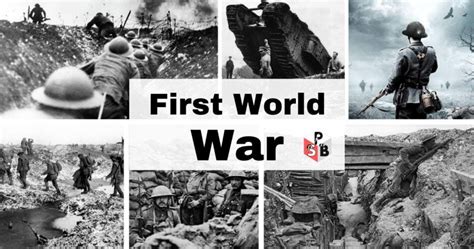World War I, also known as the Great War, was a global conflict that lasted from 1914 to 1918. The war involved all of the great powers of the time, including Great Britain, France, Russia, Germany, Austria-Hungary, and the United States. More than 9 million people were killed in the war, and more than 20 million were wounded.

The start of World War I is often attributed to the assassination of Archduke Franz Ferdinand of Austria on June 28, 1914. However, there were many other factors that contributed to the outbreak of war, including the rise of nationalism, the growth of militarism, and the complex system of alliances that had been formed between the European powers.
The Assassination of Archduke Franz Ferdinand
Archduke Franz Ferdinand was the heir to the Austro-Hungarian throne. On June 28, 1914, he was assassinated by Gavrilo Princip, a Serbian nationalist. The assassination took place in Sarajevo, the capital of Bosnia-Herzegovina, which had been annexed by Austria-Hungary in 1908.
The assassination of Archduke Franz Ferdinand sent shockwaves throughout Europe. Austria-Hungary immediately accused Serbia of being behind the assassination, and demanded that Serbia punish those responsible. Serbia denied any involvement in the assassination, but refused to accept all of Austria-Hungary’s demands.
The Outbreak of War
On July 28, 1914, Austria-Hungary declared war on Serbia. Russia, which had a mutual defense pact with Serbia, immediately mobilized its army. Germany, which had a mutual defense pact with Austria-Hungary, declared war on Russia on August 1. France, which had a mutual defense pact with Russia, declared war on Germany on August 3. Great Britain, which had a mutual defense pact with Belgium, declared war on Germany on August 4.
The outbreak of war in Europe quickly spread to other parts of the world. By the end of 1914, the war had spread to Africa, Asia, and the Americas.
The Causes of World War I
The assassination of Archduke Franz Ferdinand was the immediate trigger for the outbreak of World War I. However, there were many other factors that contributed to the outbreak of war, including:
- Nationalism: The rise of nationalism in Europe led to increased competition between the European powers for territory and resources.
- Militarism: The European powers had been engaged in a arms race for several years before the outbreak of World War I.
- Alliances: The European powers had formed a complex system of alliances that made it difficult for any one power to remain neutral in a conflict.
The Impact of World War I
World War I had a profound impact on the world. The war led to the deaths of millions of people, the collapse of several empires, and the redrawing of the map of Europe. The war also had a significant impact on the development of modern warfare.
The Legacy of World War I
World War I is often seen as a turning point in history. The war marked the end of the old order in Europe and the beginning of a new era. The war also had a significant impact on the development of international relations and the global balance of power.
Conclusion
The assassination of Archduke Franz Ferdinand was the immediate trigger for the outbreak of World War I. However, there were many other factors that contributed to the outbreak of war, including the rise of nationalism, the growth of militarism, and the complex system of alliances that had been formed between the European powers. World War I had a profound impact on the world, and its legacy can still be seen today.
Table 1: Key Dates in the Outbreak of World War I
| Date | Event |
|---|---|
| June 28, 1914 | Assassination of Archduke Franz Ferdinand |
| July 28, 1914 | Austria-Hungary declares war on Serbia |
| July 30, 1914 | Russia mobilizes its army |
| August 1, 1914 | Germany declares war on Russia |
| August 3, 1914 | France declares war on Germany |
| August 4, 1914 | Great Britain declares war on Germany |
Table 2: The European Powers and Their Alliances
| Power | Alliance |
|---|---|
| Austria-Hungary | Triple Alliance (with Germany and Italy) |
| France | Triple Entente (with Great Britain and Russia) |
| Germany | Triple Alliance (with Austria-Hungary and Italy) |
| Great Britain | Triple Entente (with France and Russia) |
| Italy | Triple Alliance (with Austria-Hungary and Germany) |
| Russia | Triple Entente (with France and Great Britain) |
Table 3: The Impact of World War I
| Category | Impact |
|---|---|
| Deaths | More than 9 million people killed |
| Wounded | More than 20 million people wounded |
| Economic | The war cost the belligerents an estimated $338 billion |
| Political | The war led to the collapse of several empires, including the Austro-Hungarian, German, Ottoman, and Russian empires |
| Social | The war had a profound impact on the social fabric of Europe, leading to the rise of new social movements and the decline of traditional values |
Table 4: The Legacy of World War I
| Area | Legacy |
|---|---|
| International relations | The war led to the creation of the League of Nations, the first international organization dedicated to promoting peace |
| Global balance of power | The war shifted the global balance of power away from Europe and towards the United States and Japan |
| Warfare | The war led to the development of new weapons and tactics, including the use of poison gas and tanks |
| Culture | The war had a profound impact on the culture of Europe, leading to the rise of modernism and the decline of traditional values |
